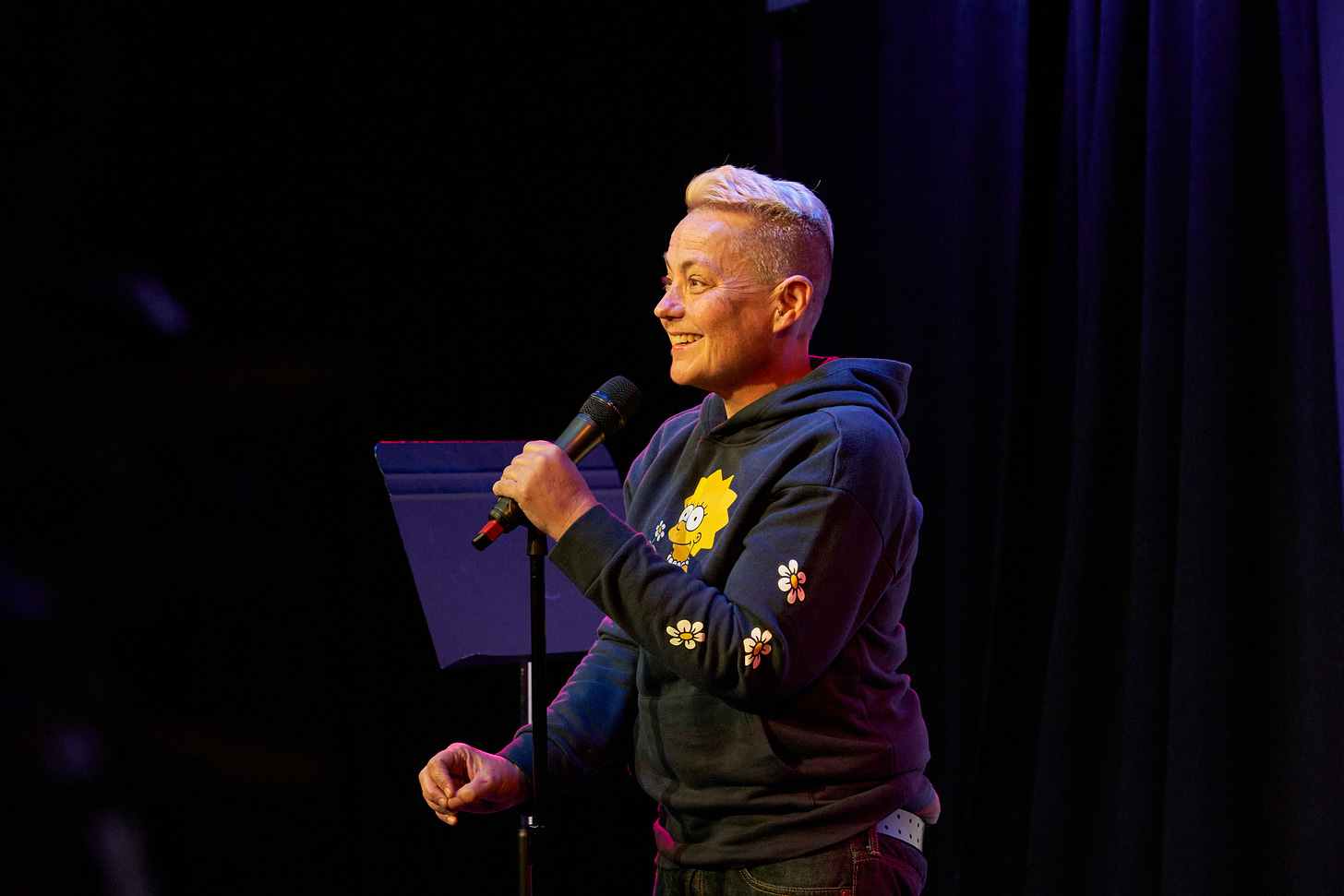Ashes to Ashes, Trust to Trust
What I’ve learned from having a tattoo made of my dead partner’s ashes

I’m not embarrassed by any of my tattoos even though by all rights I should be since they range in character from dubious (a combat boot-clad rabbit wielding a labrys) to nerdy (a diagrammed sentence on my forearm) to downright corny (a turquoise smiling dolphin jumping over some waves).
The lack of embarrassment doesn’t come from misunderstanding how stereotypical it is for a middle-aged queer person to be emblazoned with a faded dolphin tattoo obtained c. 1994. But each of these tattoos tells a story of who I was at that moment. Aesthetics be damned.
Of course, I have about three different clothing items that I wash and re-wear like I’m a Catholic schoolboy with a uniform, so I suppose an argument could be made that aesthetics have never really been my strong point.
So while I won’t try to defend the dolphin on my wrist or the Tasmanian devil on my ass, the tattoo centered on my upper chest has a special place in my heart and near it. And a startlingly practical use.
In 2005, six months into a dizzying long-distance romance with Heather MacAllister, the woman I called my Queen, she had a recurrence of ovarian cancer that had nearly killed her several years before. She was living in San Francisco, and I was living in Philadelphia. Almost overnight, our relationship went from frequent visits supplemented by late-night phone sex to difficult visits supplemented by desperate late-night phone chats.
She was in pain, had restarted chemo, and had unremitting nausea for nine weeks. She had been very sick in the past and was growing weary of the hope/hopeless spirals. She began asking me questions like, “How much fighting is enough?” I knew these questions were rhetorical—or hoped they were because I had no answers.
At one point, her somewhat socially awkward oncologist told her somewhat awkwardly that she might have just three weeks to live. My Queen’s response was to find another oncologist, one willing to take a chance and give her a more aggressive treatment. Then, she got better. Much better. It wasn’t clear how long the “much better” would last, but my Queen wanted to move to Portland, Oregon, where it was easier to be sick and broke, so I joined her.
When I mused over who would watch my cats while I lived on the West Coast, my Queen laughed and said, “Uh yeah, it’s not like I’m cured. It’s not exactly a long-term commitment.”
We had a life in Portland right then, in the shadow of her seemingly imminent death. We traveled, hosted a huge Halloween party in our barely converted Hare Krishna Temple apartment, and invited Heather’s family to celebrate an early old-fashioned Christmas where we strung cranberries and popcorn to decorate the tree. This was emotionally pleasing to me, esthetically pleasing to Heather, and gastronomically pleasing to the mice who came down from the attic at night to feast on our decorations.
At my request, my Queen began to design a tattoo that would—as we often said—leave her mark on me. In the center was a stylized letter M, which was the first letter of her last name, surrounded by stars and sprigs of Scottish Heather, which referenced a trip to Scotland we had taken the previous year and her first name. We had planned for the two of us to go together, on Valentine’s Day, to the artist she had chosen, a woman who worked at the combination tattoo shop/coffee shop (it was Portland, after all) down the street from our home.
On February 13, Heather used Oregon’s medical aid in dying law to end her life before ovarian cancer could take it from her. She gathered 30 of her nearest and queerest around for a day-long goodbye event involving people of all genders and states of dress—men in fairy wings, women wearing leather chaps, a genderqueer bagpiper playing Catholic hymns and almost everyone donning a feather boa at some point in the festivities.
Then she ate a bowl full of chocolate pudding laced with seconal. Then she died.
On February 14, Heather’s sisters went with me to the tattoo place. The artist finished the sketch of a large crown surrounded by stars, and we did that tattoo in one sitting, the artist’s assistant awkwardly handing me tissue after tissue so my tears wouldn’t run down my neck and contaminate the site.
Three weeks later, when we got Heather’s ashes from the funeral home, we opened the cardboard box while a friend with tattooing equipment prepared black ink. A few of Heather’s closest gathered and we each received a fill-in of a pre-existing tattoo, the black ink swirled with Heather’s ashes. For me, it was the stars around the M that Heather had designed.
I always said I would never love anyone like Heather again, and that was true. A few years later, I met someone very unlike Heather. Cheryl was a hard-working, introverted performance poet with razor-sharp humor.
She asked about my tattoo during our first sexual encounter while she was touching my chest.
Feeling that it was perhaps bad manners to let someone stroke an area of one’s body with cremains inserted under the skin, without sharing the information, I told her an abbreviated version of the story.
“So,” she said, not moving away from me, “the tattoo itself is filled with a dead person’s ashes?”
I nodded, frozen with anxiety.
“Does that weird you out?”
She thought for a moment.
“I mean…um, why? Is it unsanitary or something?”
And then we both started laughing and couldn’t stop.
“Is it unsanitary or something,” became our shorthand for casual acceptance of difficulties or complications either of us was bringing to the relationship and extended to bouts with depression, unannounced visits from angry parents, underemployment, and differing housecleaning priorities.
I called Cheryl my “miracle love.” But a year and a half after we started dating, Cheryl was diagnosed with Hodgkin’s lymphoma. 85 percent of people who develop Hodgkin’s are cured by the standard chemotherapy. Cheryl died six months later, not from the cancer but from a pulmonary reaction to the usually life-saving chemo.
Although I was (and am) extremely grateful for the joy our relationship brought both of us, the ending seemed rather like the opposite of a miracle.
The good thing about two partners in a row dying? You get, well, a little better at it. You know what helps. I surrounded myself with the love of friends. I joined a grief group. I wrote dubious stand-up comedy about death.
Several years later, I felt ready to start dating again. It seemed, however, that the Queer Women of Brooklyn might not have been ready for me. I didn’t include The Great Ash Story in my Lex (or Feeld or Fetlife) profile, and I didn’t chat about it, for example, as I would sit down to dinner on a first date. But when the time for potential nakedness (physical and apparently metaphorical) and the sacred queer dating ritual of the Tattoo Story Exchange approached, I participated by offering an accurate, if abbreviated, summary.
When I shared my recollections with some folks, it renewed their memories: cats that needed urgent diabetes medicine, roommates locked out of apartments, or emergency dry cleaning runs.
I can’t say I didn’t understand. I lost two partners under 40 in less than five years. I wouldn’t blame anyone who didn’t want to stand next to me in a lightning storm. From an evolutionary standpoint, it’s not emotional cowardice; it’s good sense.
But when the woman who would become my current partner first heard the Great Tattoo Ash Story, she smiled and patted my chest tenderly.
“That is terrible and beautiful,” she said, “and I’m so glad you have been loved so well.”
Later, I referred to her “kind acceptance” of my tattoo. She looked at me sideways with just a touch of a frown.
“Is that what you think?” she continued, demonstrating her rightful place as the CEO of the Coalition of Matter-of-Fact Femmes. “Nope, darlin’, we all have the ashes of something we’ve suffered right under our skin. The fact that you weren’t ashamed of yours helped me believe you’d be gentle with mine.”
I vacillate; sometimes my tattoo feels like a beautiful commemoration of a love lost but always present. At other times it feels like a slightly absurd but dramatic demonstration of the importance of not making permanent decisions in early grief. Perhaps both things can be true.
But I’ve felt so no such confusion about my tattoo’s place as a shield from a potential partner who couldn’t handle the weight of my historic grief, or who thought my emotional baggage was too battered and mismatched to take on their trip. Perhaps this is the truth I should have been questioning. For the right person, having a chest full of your dead lover’s ashes apparently doesn’t have to be a barrier to overcome, especially if they see it as a bridge.
Kelli Dunham is the nonbinary ex-nun nurse storyteller comedian so common in modern Brooklyn. Kelli has appeared on the Moth Mainstage, Showtime’s Penn & Teller Bulls**t, BBC’s Religious and Ethics Hour, the Discovery Channel and is the author of seven hilarious nonfiction books about extremely non-humorous subjects.
Kelli is touring her latest show, Second Helping: Two Dead Lovers Dead Funny, to colleges, theaters, nursing conferences and even a livestock auction or two.






Thanks Open Secrets, for publishing this and for the GREAT EDITS!